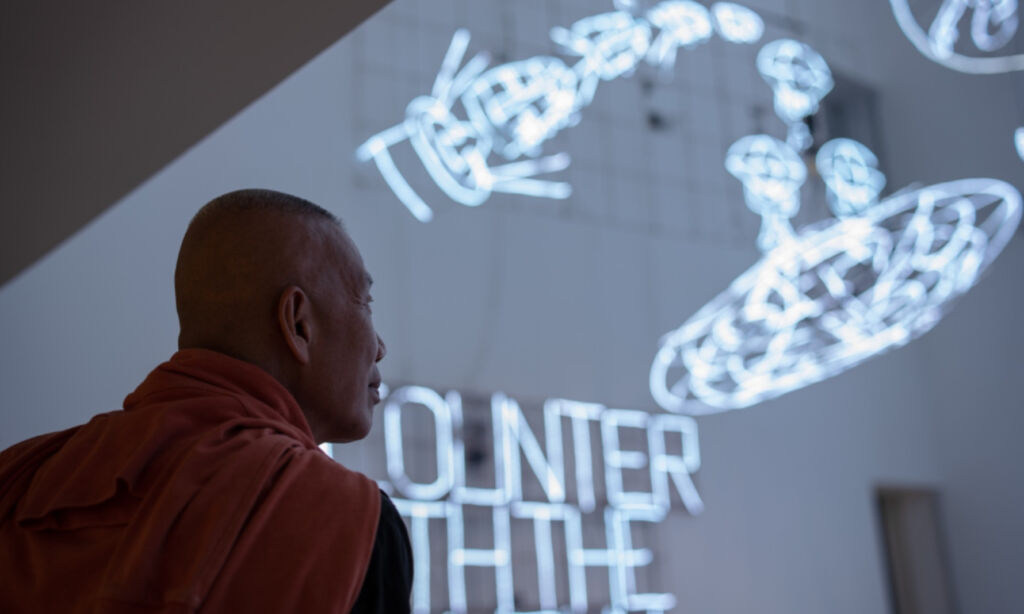Text by Katažyna Jankovska

What’s it like to reimagine ancient divination practices through the lens of new technology? When faced with uncertainty, people throughout time have sought divination. A variety of practices and tools were designed to take a glimpse into the future; people were turning to oracles, astrology, and fortune-tellers when looking for insight and guidance, asking for predictions or advice on practical matters.
Nowadays, innovative technologies have given rise to a number of possibilities for voicing ancient wisdom. Think about the I-Ching app based on the world’s oldest oracle mechanism (traditional Chinese divination practice consisting of 64 hexagrams), online tarot card readings, and fortune-telling applications, responding to the urge to tame uncertainty and our inner curiosity about the universe.
One of the recent initiatives responding to the need of getting through the chaos of today is EET – Exchange with Extraterrestrials by artist Cai Guo-Qiang in collaboration with Kanon. A digital counterpart to traditional forms of divination presents an interactive oracle system on the Ethereum blockchain.
Contrary to conventional divination practices, there is no need for a one-on-one encounter in digital divination. In EET, users can send a question about a certain concern through a texting interface on the project website and receive a fortune composed as an animated GIF generated in real-time on-chain. After receiving the fortune, oracle-seekers can chat with an AI assistant designed to help to decipher the fortune’s meaning.
Cai’s interest in invisible forces and processes happening beyond the realm is at the core of his artistic practice. Known for his gunpowder paintings and spectacular fireworks, Cai draws inspiration from Chinese Taoist spirituality and Qi Gong cosmology, incorporating those into the context of contemporary art practices.
One such practice is Feng Shui – an ancient Chinese practice that channels energy forces inhabiting structures, sites, landscapes, bodies of water, and objects to orient in the surroundings and arrange them accordingly. The use of a magnetic compass is an early example of a tool used for Feng Shui, making intangible forces visible and affecting the material world. Another influence on Cai’s practice is folk beliefs from the artist’s hometown, which acknowledge ancestors who are ghosts and spirits and remain a part of the unseen world.

Surrounded by the unseen forces continuing to shape our lives, from the dark matter to layers of reality beyond our perceptual capabilities, Cai asks, how could we represent them in tangible means? Drawing upon these practices, Cai uses the potential of innovative technology to become a new channel to connect us with processes that are beyond our immediate senses and understanding. By using his art as a tool to access the invisible world influencing our lives, Cai highlights the active presence of what is normally not addressed, tapping into the invisible.
In EET, Cai and Kanon are pairing the mechanism from the world’s oldest oracle, I-Ching, with the tools of blockchain technology. First, users type a question in the chatroom-inspired interface. Then they meditate on the question while tapping a button on the screen six times, this way generating randomness and accessing the unseen world.
This interactive element with the blockchain “oracle” in EET appears similar to certain aspects of the fortune-telling practice of kau chim in Cai’s hometown temple. In kau chim, one needs to hold and shake the cup with bamboo sticks; by doing this, one of the sticks usually falls out and then is interpreted. This process allows randomness to be tied to one’s fortune. As Cai states: The entire process in a sense restores the behavioural and psychological process of kau chim in temples, only that this time, it all happens on the blockchain and the virtual world.
Once all the information is received by the smart contract on the blockchain, users can mint two NFTs in a single transaction – GUA and EET Fortune. GUA token combines the question with randomness from the user’s movements and the Ethereum blockchain to produce an unexpected response using cryptographic functions. As Kanon explains, this response is represented by a 3×3 matrix in the form of a GIF directly encoded onto the blockchain, which is a significant technical achievement. This image is then stretched to create a fuzzy picture reminiscent of early space photography. Essentially, the GUA token is a digital version of an oracle that digitizes the ancient practice of using randomness to communicate with the universe through an oracle system, similar to rolling dice, flipping coins, casting yarrow sticks, or pulling cards.
Randomness plays a critical part in the project because most computers cannot generate true randomness as they follow a set of instructions and are, by nature, deterministic. However, it is possible to generate a random number using data from the real world. In the EET project, users are prompted to tap or click a rapidly rotating animation six times, and the EET application captures the unique fingerprint generated by the user. This fingerprint is then converted into a number and sent to the EET oracle contracts. By incorporating inputs from specific situational contexts unique to each user and unseen forces around them to determine the outcome beyond human calculation, the GUA token produces a visible result of the constant motion of different forces, the entanglement of humans and nonhumans in both material and digital realms.

GUA token is then accompanied by EET Fortune, providing an interpretation of the randomness contained within the GUA token. In real-time on-chain, EET Fortune comprises an animated GIF, a title, and six verses that resemble the written oracle in kau chim, including a title such as “supreme luck,” accompanied by several verses as textual elaboration. The written component of the EET Fortune, like in the I Ching, helps users understand the otherwise low-resolution visual component.
The EET Fortune’s multi-layered text-based elaboration includes a brief description for those who prefer a summary of their fortune and more detailed information for those interested in better understanding their current situation and future path. The format and content of the fortune texts were co-created by Cai Studio and Kanon, drawing inspiration from both traditional sources such as the I Ching Book of Changes and the writings of 18th-century Japanese commodity trader Munehisa Honma, and elements from the modern stock market and crypto market culture, which also appear to have profound connections to various aspects of Eastern philosophy.
As in traditional divination practices, answers provided by oracles and fortune-tellers are often ambiguous and elusive, requiring a seeker to decipher and interpret the message in light of the seeker’s circumstances. Likewise, the EET Fortune does not provide a straightforward answer to the user’s question – he 6 verses written component is meaningful, metaphorical, and poetic. To understand the symbolism of the answer, users have a chance to chat with the AI interpreter available to answer any questions they may have and help them understand their fortune in the context of their original question. The AI interpreter is trained using deep learning on all the EET Fortunes, and as Cai states, its role corresponds to that of the monk in the temple.
The rise in popularity of divination practices in recent years ultimately comes down to the human need to navigate confusion and insecurity. The shift of divination practices from in-person consultations to the digital realm creates new possibilities for the re-expression of ancient wisdom, where ancient merges with the contemporary. By leveraging core values unique to NFT technology, the EET project not only presents an innovative way of inquiring into the future but becomes a channel between seen and unseen realms, highlighting technology’s entanglement with other life forces capable of communicating with the wider world.






